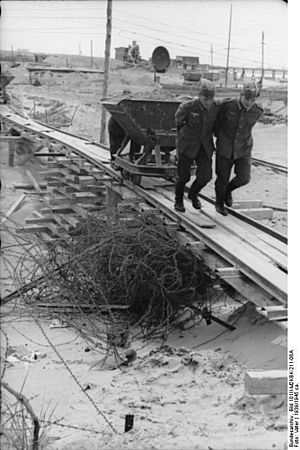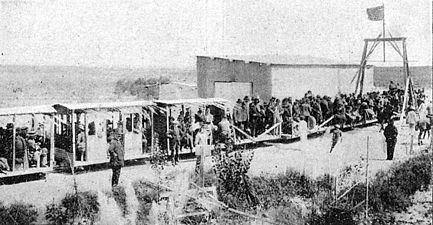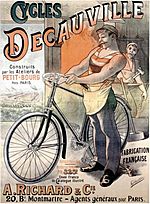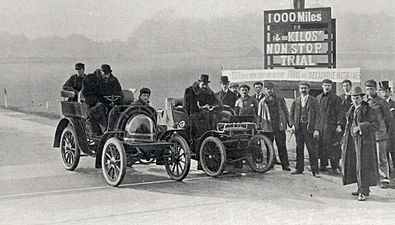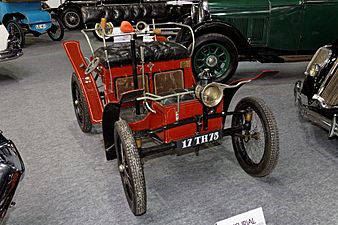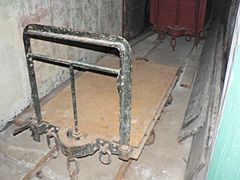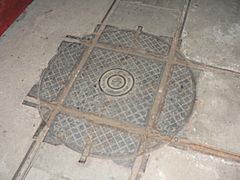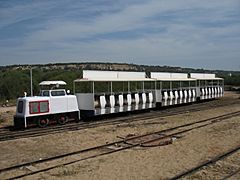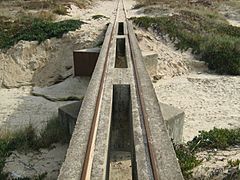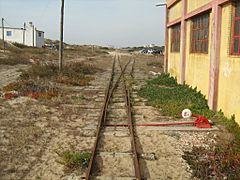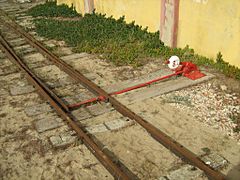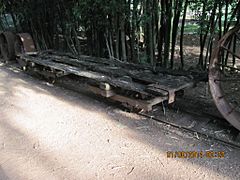Decauville facts for kids
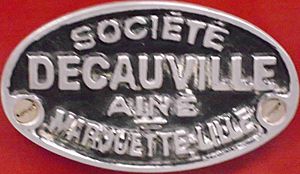 |
|
| Private | |
| Industry | Transport |
| Fate | Defunct |
| Founder | Paul Decauville |
| Defunct | ? |
| Headquarters |
Corbeil-Essonnes
,
|
|
Area served
|
Worldwide |
| Products | Rail tracks, sleepers, steam locomotives, coaches |
Decauville was a French company started by Paul Decauville (1846–1922). He was a pioneer in building special railways for factories and farms.
Decauville's big idea was to use ready-made sections of light, narrow gauge track. These tracks were fixed to steel sleepers. This made the track portable, easy to take apart, and move around.
The first Decauville railway used a 400 mm (15 3⁄4 in) gauge. Later, Decauville improved his design. He started using 500 mm (19 3⁄4 in) and 600 mm (1 ft 11 5⁄8 in) gauges.
Contents
Decauville's Story
How it Started
In 1853, Paul Decauville's father, Amand, opened a workshop. It was on their family farm. He wanted to build equipment for distilleries near Paris.
In 1864, Paul joined his father to help with the business. Paul quickly looked for ways to make the farm work better. At that time, growing sugar beets was very popular in France. Amand wanted to make this crop more profitable.
By 1867, there weren't enough workers. Amand Decauville looked for machines to help with plowing. He chose an English system by John Fowler. This system used a special engine and plow. A repair shop for these machines was added to the farm. Amand Decauville passed away in 1871. That same year, the Decauville workshops started making parts for a big railway company.
The First Portable Railway
In 1875, Paul Decauville tested different ways to move things on his farm. One idea was the "H. Corbin System." It used a wooden track that looked like a ladder. Wagons had only one axle and rested on the one before it. But this system was too weak.
That year, the farm grew a lot of sugar beets. The harvest was huge, but the fields were very wet and hard to access. Regular wagons couldn't be used. Decauville remembered the Corbin system. He decided to build a new track in his workshops. It had two square iron rails spaced 400 mm apart. They were fixed to flat iron crosspieces. A worker also suggested creating special wagons. This new setup didn't sink into the muddy ground. They quickly made many of these tracks and wagons. This helped them finish the harvest before winter.
Decauville then started making track parts, engines, and cars. These were sent to many countries, especially to colonies of European powers. In 1878, Paul Decauville built a railway at the Jardin d'Acclimatation railway. This was to show how his system could transport passengers during the 1878 World's Fair.
The Decauville Railway System
Early Sales
From 1876, the workshops worked to improve the track system and the trains. It was used all over the farm. For example, it moved manure and parts in the workshops. After a year of testing, the first products were sold. These included tracks and wagon chassis that buyers could adapt.
To show how well his "portable" railway worked, Decauville built the Tramway de Pithiviers à Toury (TPT). This railway carried many sugar beets until 1964. It also sometimes carried passengers. Just two years after the first beet harvest, the "Porteur Decauville" was very successful. Its parts were sold and delivered all over the world.
Railways for Soldiers
The French military became interested in Decauville's system in 1888. They chose the 600 mm (1 ft 11 5⁄8 in) gauge track. They used it to equip their forts. It also helped carry artillery pieces and ammunition during military trips. Decauville track was used in French military trips to Madagascar and Morocco.
By the First World War, the Decauville system was a military standard. The French and British armies built thousands of miles of trench railway track. The Germans had a similar system with standard engines. Decauville light rail track panels were also used in UK munition factories.
The Maginot Line, a strong defense line, used 600 mm railways. Some were outside, bringing supplies from main railway stations. Others were inside the forts. Electric locomotives moved loaded wagons inside the forts. Tracks inside went from the ammunition entrances to the fighting areas. Ammunition was then moved using overhead monorails.
Similar railway equipment was used in German South-West Africa. The Otavi Minen- und Eisenbahn-Gesellschaft built the 600 mm (1 ft 11 5⁄8 in) gauge Otavibahn there.
Railways for Everyday Life
A Decauville railway helped build La Plata, Argentina, in the 1880s. It carried important people from main trains to the city's founding ceremony. This 600 mm gauge rail was built by the Province of Buenos Aires Railway.
During the 1889 World's Fair, the Shah of Persia, Nasereddin Shah, visited. He liked the system and ordered 20 wagons and some rails. These were installed in Tehran for the Tehran – Rey Railway.
Decauville railways were widely used until the 1950s. They were found in construction sites, quarries, farms, and sugar cane fields. The company also made road vehicles and construction engines.
In the Mexican region of Yucatán, Decauville tram tracks were very common. They were used on henequen plantations. There were about 4,500 kilometers of track. This system became the main way to travel in the region. Some old haciendas (large estates) still have small Decauville systems. Donkeys often pull the wagons on these.
Decauville also designed the steam tramway and cars used in Saigon in 1896.
Two beaches in Portugal, Comboio da Praia do Barril and Caparica, have tourist trains. These trains use the Decauville system (600 mm or 1 ft 11 5⁄8 in gauge). They cover a total of 10 km (6.2 mi) of track.
In Argentina, Decauville portable tracks were used to carry tourists to Ostende. This city on the Atlantic coast was founded in 1913. The first tourists rode a 3 km long railway along the beach.
- Decauville wagons
Metre-Gauge Equipment
Decauville started making equipment for metre-gauge tracks around 1896. Their first locomotive weighed five tons. There was a lot of competition, but Decauville had a small but useful range of products.
In their 1897 catalog, they listed five types of locomotives. These weighed from 13 to 23 tonnes when running. A steam locomotive was built in 1908 for a line from Berck-Plage to Paris-Plage. For towed equipment, they had two wagons: a tipping wagon and a flat ballast wagon.
By the 1908 catalog, the range had grown a lot. Decauville started to focus on equipment for railways in colonies. They made very large metre-gauge machines, up to 32 tonnes. These were for railways in places like French Sudan. They offered 20 car models, many designed for hot climates. There were also 14 types of wagons, mostly covered.
In 1939, Decauville built three 'DXW' type railcars for Yunnan in China. This was near the border with Indochina. However, the Indochina War stopped them from being sent. In 1951, the French national railway company bought them. They were used on the Breton network.
The 'Z 600' equipment for the Saint-Gervais-Vallorcine line was made by Decauville. It was delivered in 1958.
Other Things Decauville Made
Besides railways, Decauville quickly started making other products. These included farm machines, electric motors, and bicycles.
Cars and Bikes
From 1891 to 1902, Decauville made six models of bicycles. Some could even travel on railway tracks. They had a special system with three tubes and a roller. A famous product was their tricycle. It was used as a base for a prototype by another company, De Dion-Bouton.
Decauville also entered the car industry. They had a car branch called Decauville automobile. They had already made 3,000 motor tricycles for the De Dion-Bouton company. After years of study, Decauville showed its Voiturelle (1898-1903). This small three-seater car was designed in Bordeaux. It had a gasoline engine.
Decauville designed a new car frame, shown in 1902. This 1902 model was very flexible. You could change seats and engines. It became very popular. However, after 1907, orders for cars dropped. Decauville was slow to react to this problem. So, they stopped making cars in 1909. They continued to sell cars they had in stock until 1911.
- Decauville automobiles
Images for kids
-
Decauville 0-4-0 wt steam locomotive, Hauts-de-Seine, France
Gallery
- Decauville products and installations
-
Decauville track in the Maginot Line in the French Alps
-
Decauville system tourist train at Costa da Caparica, Portugal
See also
 In Spanish: Decauville para niños
In Spanish: Decauville para niños
- Bathurst Decauville Tramway
- Benjamin Constant railway
- Decauville automobile
- Decauville Tramway at Exposition Universelle in Gent, 1913
- Decauville wagon
- Feldbahn
- Forest railway
- Heeresfeldbahn
- Light railway
- Military railways
- Minimum gauge railway
- Mountain railway
- Trench railways
- Mogadishu-Villabruzzi Railway extension



